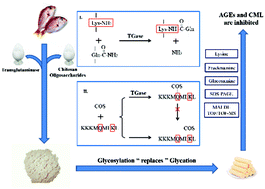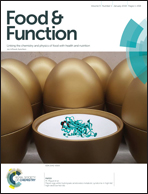Inhibition of advanced glycation endproducts during fish sausage preparation by transglutaminase and chitosan oligosaccharides induced enzymatic glycosylation
Abstract
Advanced glycation endproducts (AGEs) are the harmful products of non-enzymatic reactions in foods formed during the heating process. In order to reduce the content of AGEs in foods, the inhibitory effect of different proportions of transglutaminase (TGase) and chitosan oligosaccharides (COS) on the AGEs of seabream fish meat sausage was studied. The results indicated that the TGase/COS ratio of 1 : 1 could inhibit the formation of AGEs, showing especially a decreased Nε-carboxymethyl-lysine (CML) content and a twice higher inhibition rate (36.4%) than that by aminoguanidine (17.4%), a commonly effective positive inhibitor of AGEs. The data of lysine, fructosamine, and glucosamine contents, combined with sodium dodecyl sulfate-polyacrylamide gel electrophoresis and matrix-assisted laser desorption/ionization time-of-flight mass spectrometry analyses, demonstrated that cross-linking of proteins and glycosylation of glutamine induced by TGase and COS resulted in steric hindrance that inhibited glycation. These findings revealed that TGase catalyzed glycosylation with COS differently from general antioxidants had potential as an effective treatment to inhibit the formation of AGEs in fishery products.



 Please wait while we load your content...
Please wait while we load your content...